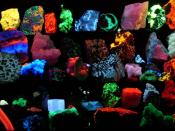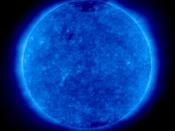Ultraviolet Rays Ultraviolet rays are part of the electromagnetic spectrum. It has wavelengths shorter than Visible light but longer than X-rays. It moves at 186,000 miles per second, the speed of light. The difference between ultraviolet rays and any other one is their wavelength, the amount of energy waves can carry. Ultraviolet radiation has a range of wavelengths of about 10 NM to 400 NM. Ultraviolet light is generally divide into the near (4000- 3000A), the far (3000- 2000A), and the vacuum (2000- 40 A) ultraviolet region. The John Ritter discovered ultraviolet region or the spectrum in 1801. The sun contains ultraviolet waves, which can burn your skin.
Most of the waves are blocked by the Ozone layer, in the earth's upper atmosphere. The Ozone layer in the earth's upper atmosphere, as well as atmospheric oxygen and nitrogen keeps out all ultraviolet radiation with wavelengths shorter than 2900 A from reaching the earth's surface.
A little dose of ultraviolet radiation will not hurt a person, can be useful to support.
health. A large dose of ultraviolet radiation can cause: premature wrinkling of the skin, cataracts, muscular degeneration, growth of the eyes, and skin cancer.
You should wear sunglass, hat, or something to keep the sun out of your eyes because of the ultraviolet rays.
Early in the morning you should go out side before 10:00 am, or after 4:00 pm because it is not so hot and the ultraviolet is not so bad between those times.
Ultraviolet is a form of invisible light. Ultraviolet rays are sometimes known as Black Light, because most of them can not be seen directly by human eyes.
Major sources of ultraviolet rays are: sun, lightning, or any other electrical sparks in the air.
Ultraviolet rays shorter than 320 NM can be used to kill...


